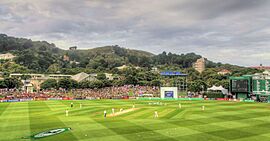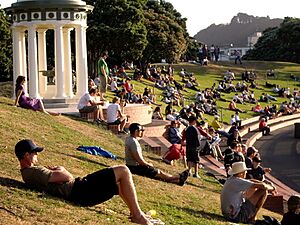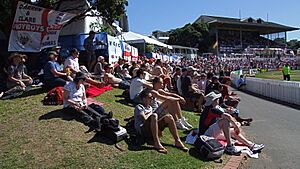Basin Reserve facts for kids
| The Basin | |||

A view of Basin Reserve in 2008
|
|||
| Ground information | |||
|---|---|---|---|
| Location | Mount Cook, Wellington, New Zealand | ||
| Coordinates | 41°18′1″S 174°46′49″E / 41.30028°S 174.78028°E | ||
| Establishment | 1868 | ||
| Capacity | 11,600 | ||
| End names | |||
| Vance Stand End Scoreboard End |
|||
| International information | |||
| First Test | 24–27 January 1930: |
||
| Last Test | 6-10 December 2024: |
||
| First ODI | 9 March 1975: |
||
| Last ODI | 5 January 2025: |
||
| First women's Test | 20–23 March 1948: |
||
| Last women's Test | 26–29 January 1990: |
||
| First WODI | 23 January 1982: |
||
| Last WODI | 1 April 2024: |
||
| First WT20I | 28 February 2016: |
||
| Last WT20I | 29 March 2024: |
||
| Team information | |||
|
|||
| As of 5 Janurat 2025 Source: CricketArchive |
|||
The Basin Reserve, also known as The Basin, is a famous cricket ground in Wellington, New Zealand. It hosts important Test matches and is the main home for the Wellington Firebirds team. The Basin Reserve is special because it's the oldest first-class cricket ground in New Zealand. It's even listed as a heritage site! Besides cricket, it has also been used for other events like association football games and concerts.
The New Zealand Cricket Museum is inside the Old Grandstand. It has cool cricket items and a library. It first opened in 1987 and was updated in 2021.
Contents
Exploring the Basin Reserve's Location
The Basin Reserve is about two kilometers south of Wellington's city center. It sits at the bottom of Mount Victoria. Nearby, you can find Government House, St Marks Church School, and Wellington College. The Mount Victoria Tunnel, built in 1931, is at the eastern end.
Many other Wellington landmarks surround the Basin Reserve. These include Mount Cook Barracks and the National War Memorial. A fire station is across the street. Firefighters there used to watch games and sound their siren when New Zealand took a wicket or a player scored 50 or 100 runs! The Basin Reserve is where the Wellington areas of Mount Cook, Newtown, and Mount Victoria meet.
How the Basin Reserve Was Built
The area where the Basin Reserve now stands was once a lake. There were even plans to connect it to the sea with a canal! But a huge 1855 Wairarapa earthquake lifted the land by almost 1.8 meters. This turned the lake into a swamp. People in Wellington loved sports, especially cricket, but there wasn't much flat land for games.
After the earthquake, in 1857, some important citizens suggested draining the new swampy land. They wanted to turn it into a sports area. The Wellington council agreed, and in 1863, prisoners started to level and drain the land. By September, the swamp was gone, and a fence was put up.
On December 11, 1866, the Basin Reserve officially became Wellington's cricket ground. No animals were allowed, and only small plants were permitted so they wouldn't get in the way of games. The first cricket game was played on January 11, 1868. The ground was still a bit rough with stones and thistles, which the umpire apologized for!
Soon after, the Highland Games started to be held there. These games were organized by the Wellingtonian Caledonian Society. They offered prize money, which brought many competitors. Because the games were so popular, new grandstands were built. These stands were about 44 by 20 feet and cost around £250–£300. They also had food stalls.
Even with the new stands, the ground was still quite swampy until late 1872. Horses were then used to level the playing field, which made it much better.

In 1882, the William Wakefield Memorial was put up at the Basin Reserve. This monument honors William Wakefield, an important early Wellingtonian.
The pavilion at the Basin Reserve has been a registered Historic Place since 1982. The entire Basin Reserve became a registered Historic Area in 1998. The William Wakefield Memorial is also a very important historic site.
In 2012, the Museum Stand was closed because of earthquake risks. A new players' pavilion opened in December 2018. It was later named in 2020 after the famous cricketer Ewen Chatfield.
The Scoreboard at the Basin Reserve
The main scoreboard is named after cricket historian Don Neely. In 2002, a commentator named Mike Selvey famously called it the "ransom-note scoreboard." This was because it used many different types of letters and numbers!
Exciting Events at the Basin Reserve
The very first event at the Basin Reserve was a cricket match on January 11, 1868. It was between the Wellington Volunteers and the crew of a ship called HMS Falcon. The game was a bit tough because of all the stones and thistles on the field!
After that, local groups started holding athletic and social events. These became known as the Highland Games. Their success led to the first grandstand being built. The games included running, dancing, and even wood-chopping. The ground was still a bit wet, but it was fixed in late 1872. This allowed the first important cricket match to be played on November 30, 1873. Wellington won easily against Auckland.
The Basin Reserve also hosted the first rugby football match in New Zealand's North Island. A Wellington team played against the crew of HMS Rosario.
The first Test match at the ground was between New Zealand and England. It started on January 24, 1930. One-day international cricket was played here until 1999. After that, most one-day games moved to the larger Wellington Regional Stadium.
On March 13, 2011, the Basin Reserve held a special cricket event called "Fill the Basin." It raised money for people affected by the 2011 Canterbury earthquake. Over 10,000 people came! Famous players like Shane Warne and Stephen Fleming played. Even actors Russell Crowe and Ian McKellen joined in. More than $500,000 was raised for relief efforts.
On March 17, 2019, about 11,000 people gathered at the Basin Reserve for a vigil. They were mourning the victims of the Christchurch mosque shootings.
Besides cricket, other sports have been played at the Basin Reserve. These include rugby union, rugby league, association football (soccer), and Australian football. In the 1950s and 1960s, it was the main soccer venue in Wellington.
Basin Reserve Cricket Statistics
Test Match Highlights
As of June 2024, 68 Test matches have been played at the Basin Reserve. This ground is known for being good for fast bowlers. Nine out of the top ten wicket-takers here are fast bowlers! Chris Martin has taken the most wickets with 60.
Brendon McCullum holds the record for the highest score in an innings here, with 302 runs. He was the first New Zealander to score over 300 runs in a Test! Before him, Martin Crowe scored 299 runs in 1991. In 2015, Kumar Sangakkara reached 12,000 Test runs and scored his 11th double century here. Trent Boult has made some amazing one-handed catches at this ground, including one that dismissed Sangakkara in 2015.
In the same Test, Kane Williamson scored his first Test double century. His teammate BJ Watling also scored a century. Williamson's catch in that match was even shown on Sportscenter in the US! In 2017, Henry Nicholls scored his first Test century here. Later that year, Tom Blundell scored his first Test century on his debut match. He even walked home in his uniform because he lives nearby!
The highest team score in a Test match at the Basin Reserve was 680/8 by New Zealand national cricket team against Indian national cricket team in 2014. The players who have scored the most runs here are Ross Taylor (1279 runs), Kane Williamson (1137 runs), and Martin Crowe (1123 runs).
One Day International (ODI) Match Records
In ODI cricket, the highest score by a team was 315/7 by New Zealand against Pakistan in 2018. The most runs scored by individual players are by Martin Crowe (345 runs), Andrew Jones (311 runs), and Nathan Astle (285 runs).
The most wickets in ODIs have been taken by Danny Morrison (16 wickets), Chris Harris (13 wickets), and Gavin Larsen (12 wickets). It's quite rare to score an ODI century at the Basin Reserve; only four have ever been made! The most recent was by Martin Guptill in 2018.
International Rugby League Matches
Between 1919 and 1953, the Basin Reserve hosted five rugby league Test matches. All of them involved the New Zealand national rugby league team. New Zealand won three of these five games.
* Even though it was the Great Britain team, they were called Northern Union in 1920. They played as England in 1924, even with some Welsh players.
See also
- List of Test cricket grounds
- List of international cricket centuries at Basin Reserve
- List of international cricket five-wicket hauls at Basin Reserve



